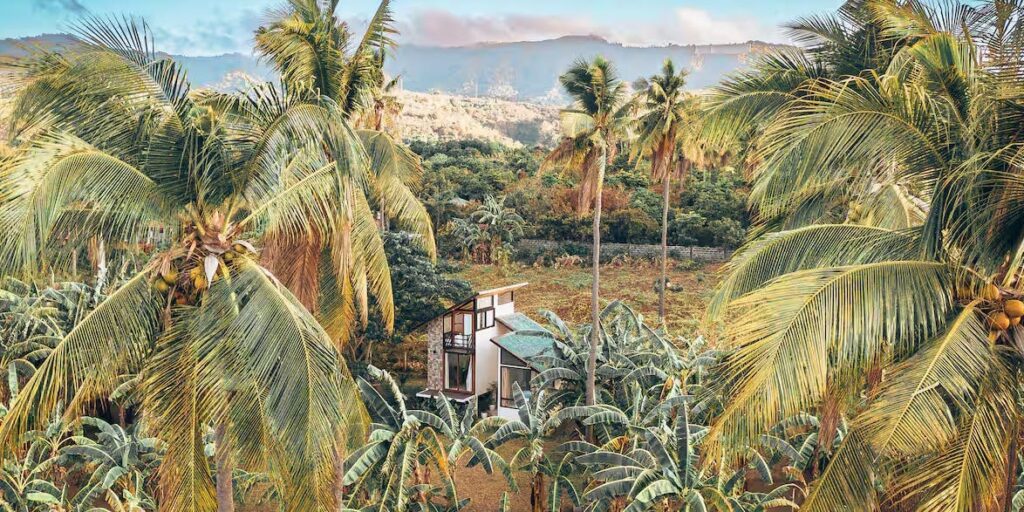In 2022, Eunice Panopio brought her tiny house dream to life by building one in the Philippines and turning it into an Airbnb.
The idea first came to her in 2018, when she was handling social media marketing for a woman who managed resorts. Watching bookings pour in, she began to wonder what it might be like to build a place of her own.
“I was like, ‘I hope I can do that for myself,’ but I never had the funds,” Panopio told Business Insider.
Fast-forward a few years, and Panopio was studying marketing and communications in Melbourne, Australia. On the side, she freelanced as a graphic designer and photographer and worked weekend shifts waiting tables.
Eunice Panopio.
“That’s how I figured I should use the money that I’m earning in Australia to do my long-overdue dream,” said Panopio, now 27, an entrepreneur who also works in social media marketing.
Bringing a vision to life
Building a tiny house in Australia would have been too expensive. Instead, Panopio decided to build in the Philippines, where she grew up.
She already knew of an empty 1.3-hectare plot in Talisay, Batangas, about a 90-minute drive from Manila, that she thought would be ideal.
The land overlooks Taal Volcano and its surrounding lake, a popular tourist destination and national park. She had gone camping there as a kid, and the landscape left a deep impression.
“My friend’s family owns the land, but they moved abroad, so it’s just there,” she said. They were open to the idea of Panopio building something on the property.
When it came time to design the tiny house, Panopio drew inspiration from her travels but wanted to use furniture and building materials made in the Philippines.
Eunice Panopio.
Most contractors quoted her prices in the millions. She ultimately went with the one who said he could do it for 750,000 Philippine pesos.
Because she couldn’t cover the full cost as a student, Panopio partnered with an acquaintance of her father’s from church.
The investor contributed about 500,000 pesos, which Panopio used to pay her contractor upfront. Panopio paid the rest in installments over the next couple of months, she said.
Eunice Panopio.
The tiny house was completed in over a month in 2023, with Panopio managing most of the project remotely from Australia.
She wasn’t in the Philippines for the first few weeks of the project, but returned to oversee the interior design as the remaining work was finished.
The biggest challenge was installing water and electricity. Both had to be extended from the main road, a two-minute walk away.
Managing a rental business
The tiny house sits on a 16,000-square-foot lot and comprises two buildings connected by a sheltered walkway.
One has a loft with a king-sized bed for guests, while the other houses the bathroom, complete with a large circular tub framed by windows that overlook the surrounding greenery.
Eunice Panopio.
A highlight of the 388-square-foot tiny house is its use of reclaimed wood, much of which local carpenters gave to Panopio for free.
“I do find the beauty in them, especially woods that have irregular cuts or irregular colors. I really like those,” she said.
Nightly rates range between 7,000 and 8,500 Philippine pesos, or about $123 to $150, depending on the season. Each stay includes a complimentary dinner.
Eunice Panopio.
The tiny house has a 4.89-star rating on Airbnb based on 56 reviews.
At first, Panopio thought Airbnb would be passive income. “But I quickly realized it took more work than I expected if I wanted guests to have a good experience,” she said. Guest communication, check-ins, and maintenance always require her attention.
Eunice Panopio.
So far, she’s only dealt with one particularly difficult guest.
“I made sure everything she mentioned didn’t happen to other guests,” she said, adding that she now sets expectations early by explaining the property’s unique setup.
A space to disconnect
Panopio’s project is part of the global tiny house movement, which has gained traction as both a lifestyle and a business model.
In 2019, six tiny house owners told Business Insider that living tiny reduced their housing expenses. Some of them even convert their tiny houses into rentals when they travel to earn extra income.
“We could not have afforded to set up such a luxurious rental if we had continued to rent or even bought a starter home — and renting our house for a handful of months a year covers the costs of ownership,” one couple in California told Business Insider.
Even as cities like New York and Barcelona crack down on short-term rentals, Airbnb maintains a footprint across Asia.
Eunice Panopio.
An Oxford Economics report commissioned by Airbnb estimated that the platform added 113 billion Philippine pesos to the country’s GDP in 2024.
Other young Filipinos have taken the plunge too. One couple built a tiny house an hour from Manila as a weekend retreat and turned it into a guesthouse when they moved abroad.
In Panopio’s case, most of her guests book the tiny house for short getaways.
“Since it’s just 10 minutes away from the volcano, guests can rent Jet Skis around the lake, or they could also go fishing,” Panopio said, adding that there’s an amusement park nearby.
When she designed the tiny house, Panopio’s goal was to make it Instagrammable. But she soon realized most guests hardly use their phones during their stay.
For the first 18 months, the house didn’t even have internet — and no one complained. “Now that we have it, sometimes people don’t even ask,” she said. “They go there to not use the internet.”
Do you have a story to share about building an Airbnb or your dream home in Asia? Contact this reporter at agoh@businessinsider.com.


